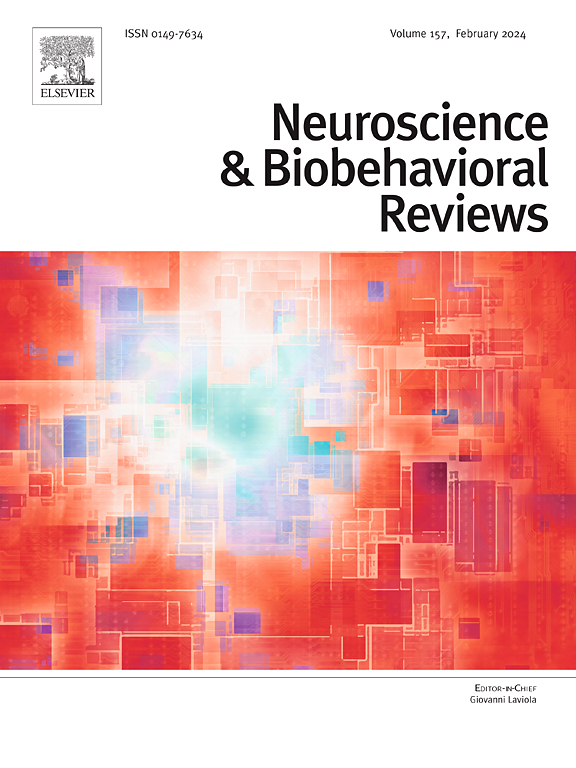旨在促进心理压力下儿童和青少年恢复力的社会心理干预的干预后神经影像学效果:系统综述
IF 7.5
1区 医学
Q1 BEHAVIORAL SCIENCES
引用次数: 0
摘要
童年和青春期是神经发育的关键时期,在此期间,心理逆境会增加随后出现心理健康问题的风险。然而,在此期间增加的神经可塑性也赋予了发展弹性的潜力,这现在被视为适应逆境的动态过程。这项预注册系统综述(PROSPERO-CRD42024537715)总结了非侵入性、非药物干预的干预后神经影像学结果,旨在促进平均年龄为 25岁暴露于任何显性心理压力的样本的恢复能力。涉及创伤性或局灶性脑损伤的研究被排除在外。检索了MEDLINE、PsycINFO和CENTRAL数据库,检索时间为2024年7月14日。磁共振成像(MRI)结果是主要的焦点。偏见风险是根据乔安娜布里格斯研究所的清单项目进行评估的。由于研究异质性,我们进行了叙事综合。我们确定了13项符合条件的研究:1项报告结构和弥散加权MRI(干预2年后进行),1项静息状态fMRI(干预结束后14年)和11项基于任务的fMRI指标(从干预后立即到干预结束后8年)。在基于任务的功能磁共振成像中,弹性干预降低了边缘活动(丘脑、杏仁核和右前岛)。在年龄较大的青少年中,社会、正念和运动干预可以增强前额叶皮层(PFC)-边缘的连通性,减少边缘活动。在较年轻的青少年中,证据很少,显示pfc -边缘连通性的混合影响。5项研究存在高偏倚风险;最常见的限制是没有干预前的MRI扫描。总的来说,这项研究总结了有希望的机制,正如神经影像学所证明的那样,通过心理社会干预可以增强压力青年的恢复力。本文章由计算机程序翻译,如有差异,请以英文原文为准。
Post-intervention neuroimaging effects of psychosocial interventions aimed at promoting resilience in children and adolescents under psychological stress: A systematic review
Childhood and adolescence are neurodevelopmentally critical periods, during which psychological adversity can increase the risk of subsequent mental health difficulties. However, the increased neuroplasticity during this window also confers potential for developing resilience, which is now seen as a dynamic process of adapting to adversity. This pre-registered systematic review (PROSPERO-CRD42024537715) summarises the post-intervention neuroimaging outcomes of non-invasive, non-pharmacological interventions aimed at promoting resilience in samples with a mean age of < 25 years exposed to any explicit psychological stress. Studies involving traumatic or focal brain lesions were excluded. MEDLINE, PsycINFO and CENTRAL databases were searched from inception to 14/7/2024. Magnetic Resonance Imaging (MRI) outcomes were the primary focus. Risk of bias was assessed against adapted Joanna Briggs Institute checklist items. A narrative synthesis was conducted due to study heterogeneity. We identified 13 eligible studies: 1 reporting structural and diffusion-weighted MRI (performed after 2 years of intervention), 1 resting-state fMRI (14 years after end of intervention) and 11 task-based fMRI metrics (ranging from immediately post-intervention to 8 years after end of intervention). Resilience interventions reduce limbic activity (thalamus, amygdala and right anterior insula) in task-based fMRI. In older adolescents, social, mindfulness, and exercise interventions strengthen Prefrontal Cortex(PFC)-limbic connectivity, decreasing limbic activity. Evidence in younger adolescents is sparse, showing mixed effects on PFC-limbic connectivity. Five studies were at high risk of bias; the most common limitation was no pre-intervention MRI scans. Overall, this study summarises promising mechanisms, as demonstrated on neuroimaging, through which resilience can be enhanced in stressed youth through psychosocial interventions.
求助全文
通过发布文献求助,成功后即可免费获取论文全文。
去求助
来源期刊
CiteScore
14.20
自引率
3.70%
发文量
466
审稿时长
6 months
期刊介绍:
The official journal of the International Behavioral Neuroscience Society publishes original and significant review articles that explore the intersection between neuroscience and the study of psychological processes and behavior. The journal also welcomes articles that primarily focus on psychological processes and behavior, as long as they have relevance to one or more areas of neuroscience.

 求助内容:
求助内容: 应助结果提醒方式:
应助结果提醒方式:


